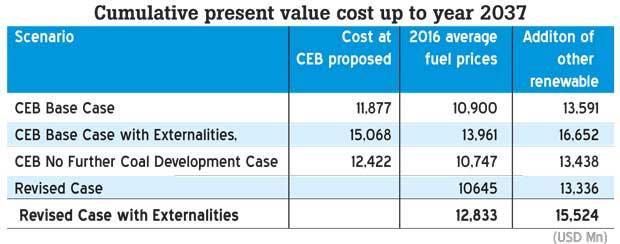21 Jul 2017 - {{hitsCtrl.values.hits}}

By Chandeepa Wettasinghe
Amidst lobbying from environmentally-conscious stakeholders, the Public Utilities Commission of Sri Lanka (PUCSL) approved a revised coal-free power generation scenario for the next 20 years at a present value of US$ 15.52 billion, in the process saving US$ 1.13 billion over the Ceylon Electricity Board’s (CEB) coal-heavy option.
The CEB had initially submitted three Least Cost Long Term Generation Expansion Plans (LCLTGEPs) for the period 2018-2037, with the CEB’s preferred base case depending mostly on coal, a restricted coal option, and a no-coal option.
Twelve further scenarios were formulated upon the insistence of PUCSL. “After going through all these scenarios, with the relevant data and analysis, basically the Commission has approved one of the first 3 scenarios that the CEB submitted; that is the no-coal scenario,” PUCSL Director General Damitha Kumarasinghe said yesterday.
Late last year, following lobbying and legal action by environmentalists, a 500 Megawatt (MW) coal power plant in Sampur was halted by the Supreme Court. The approved plan calls new capacities of 4,800 MW of natural gas, 1,205 MW of wind, 1,389 MW of solar, 330 MW of furnace oil, 242 MW of major hydro, 215 MW of mini-hydro and 105 MW of gas turbine generation.
As reported by Mirror Business, the public consultation process for the CEB’s LCLTGEP 2018-2037 held last month saw experts—even from within the state sector—criticizing the CEB for manipulating statistics to show scenarios where coal will be cheaper than it should be.
The CEB achieved this by basing future coal prices on an average pricing for the years 2015 and 2016 to take advantage of all-time low coal prices in 2015, compared to high coal prices from the end of 2016 till now.
“Using such long-term (2015 and 2016) average, when the current prices are substantially different appears to misrepresent the actual pricing at the time of preparation of the plan. Most notably, they have used the existing market prices for oil products (which is with taxes etc, and excessively higher than the border prices),” PUCSL said in a statement.
Further, experts had lambasted the CEB for not including externalities (such as damages to the environment and the society) in the LCLTGEP, which further favoured coal power generation as the country’s power generation backbone over the less harmful natural gas, which generates power cheaper than coal when accounting for externalities.
The addition of renewable energy sources such as wind and solar adds US$ 2.69 billion to each scenario, which is included in the US$ 15.52 billion cost.
However, Kumarasinghe said costs of renewable energy plants have been continuously decreasing, and will likely continue to do so in the future.
He noted that natural gas combined with renewables, revised based on PUCSL analytics, was the most suitable option for Sri Lanka at the present time.
“Given Sri Lanka’s power demand curve, the natural gas scenario becomes cheaper than coal due to the flexibility of natural gas power generation,” he said.
Coal power plants are unable to quickly adapt to changes in electricity demand—especially falls in demand.
If a coal power plant goes offline, it could take days for it to be brought back online, as was experienced by the country in recent past, which suffered through several blackouts when the Norochcholai Coal Power Plant went offline in multiple instances.
The new energy mix will break the country out of the current cycle of entering into frequent power crises, which then require the commissioning of emergency diesel power plants, which are several times costlier to operate than coal or natural gas.
“The main objective is to break out of this cycle. Hopefully if everything goes according to plan, we can break out of this cycle by 2021,” Kumarasinghe said.
However, he said that if the plan is not implemented by the various responsible agencies immediately by calling for tenders, the country may have to continue to commission and depend on diesel power plants for longer period of time.
The first natural gas plant, a 300MW project in Kerawalapitiya, is expected to be commissioned in 2019, and use imported natural gas until natural gas from the Mannar basin can be extracted, tentatively by 2023.
While the addition of natural gas to promote energy security will reduce renewable energy share in the power generation mix to 32-33 percent under the approved plan from the current 45 percent, Kumarasinghe said that the main focus of the 2018 LCLTGEP will be to increase the share of renewable power generation to 60 percent.
“In a policy document published in 2015, the government said that we should be fully reliant on renewable energy by 2030. So, I think we are moving in the right direction,” he said.
08 Jan 2025 1 hours ago
08 Jan 2025 3 hours ago
08 Jan 2025 3 hours ago
08 Jan 2025 5 hours ago